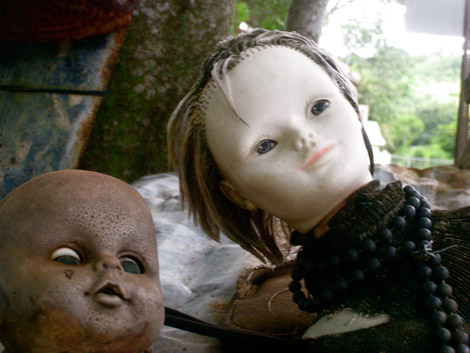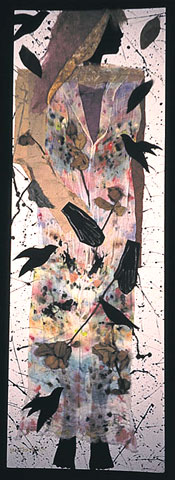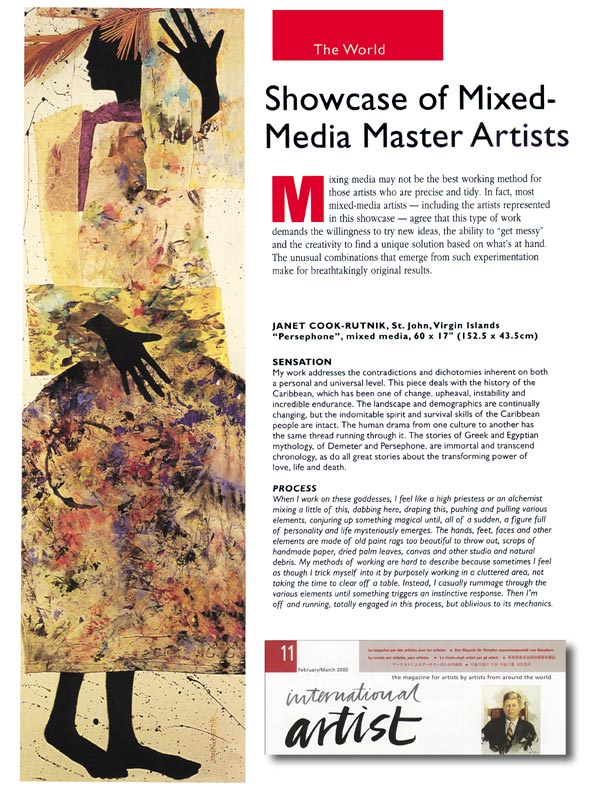
Text

The Rock/Transfer
 |
 |
| The Rock/Transfer PDF Supplement: English | Spanish | National Park Service Special Use Permit |

Moments in Time &
Paradise/Paradox

Transfer Collaboration

Our Father


Our Father (George’s Dolls)
by Janet Cook-Rutnik
The images, George’s Dolls, used in the video, “Our Father", were shot this spring and fall in George's Yard in Orange Grove, St. Croix. George is an "outsider artist" who couldn't care less about titles and concepts. The yard with its assembled piles of discarded, collected and trashed items belong to the house in which he has lived for the last 84 years - since age five. This dazzling array of recycled debris offers a mysterious kaleidoscope of imagery. Much is cast off disposable items; plastic bottles, containers, dog food bags; organized in a personal inventory system; a carnival of consumer carnage.
In the midst of this chaotic but peaceful landscape are these dolls with their childlike innocence, burnished and abandoned to the elements, sometimes carried off by the dogs, bound to displays along with other discarded items, lying face down on the ground or placed in a broken down car or rusted out frying pan. This walk through time seems a parallel to the current state of affairs in the Virgin Islands and perhaps Puerto Rico where crime and violence have reached staggering proportions, claiming many young lives and producing a frightening loss of innocence and harmony in us all. This cacophony of discordant notes produces a jarring and strange beauty evoking powerful feelings of sadness, distress and overwhelming loss.
This digitalized slideshow is underlined with Gustav Mahler’s Song No. 4, sung by Andreas Schmidt, from the song cycle, Kindertotenlieder (Songs on the Death of Children), composed between 1901 and 1904. Mahler selected five of the poems from Kindertotenlieder, a group of poems written by Rückert in 1833-34 in reaction to the illness (scarlet fever) and death of his two children…this work is described as, “singular, almost manic documents of the psychological endeavor to cope with such loss…”(Wikipedia). Rückert never intended these poems for publication. The lyrics in English follow:
Often I think that they have only stepped out
and that soon they will reach home again.
The day is fair - O don't be afraid -
They are only taking a long walk.
Yes: they have only stepped out
and will now return home.
O don't be anxious - the day is fair.
They are only taking a walk to those hills.
They have simply gone on ahead:
they will not wish to return home.
We'll catch up to them on those hills.
In the sunshine the day is fair.

Caribbean Art World Magazine

Looking the Other Way

VIEW FULL SIZE VERSION : 'LOOKING THE OTHER WAY' (345K)
(Opens in a new window)

Presence that Recalls Absence
"I understand the spiritual as a way of living the ordinary while sensing the extraordinary."
Lucy Lippard, 1997
 "Fruit of the Womb"
"Fruit of the Womb"Acrylic on Canvas
32 x 32"
Both hands covering the face, this is the basic architecture of our interiority, a personal territoire where dreams comingle with memories. The hands become a foundation; a vantage point from where the audience observes the Caribbean artist, Janet Cook-Rutnik. This display of her mythology, multi-layered influences, forms the landscape of her personal journey. The tactility of the painting in the form of a stroke, texture or iconography, forces the audience to be fully aware of their senses. We are in the presence of an art that is partially lived experience, as well as a feminist fascination with the processes of everyday life. This feminine form that dominates her work, becomes an index that under the multiple forms it takes, forgets the natural bridge to a single meaning. The figure in each scene assumes multiple roles, from sexual or didactic woman to a laboring woman, or a faraway silhouette, that speak to us from our dreamy memories. The Caribbean islands, like the "Tower of Babel" become a syncretized milieu. Continual migrations add more density to the already complex grid of identities and new dimensions of ethnicity and ideology. Janet Cook-Rutnik is aware of these influences and she develops her own aesthetic syntax from them.
In THE FRUIT OF THE WOMB, at the center of the frame, the presence of a dress; an inanimate object, implies the absence of the person who was using it. The birds, as witnesses of an endless ceremony, cohabit with the guardian serpent, while the movements of the missing body still echo and imply the fragility of the background, the ephemeral nature of our presence and the landscape. This painting becomes the setting of multiple chronological layers of time of day and multiple seasons, from the white eyes surfacing in the obscurity of night, to the daylight that the dress represents. But the artist takes it even further, the light and the objects in the dress create a new environment where we encounter a surreal inversion, the fertile dress remains in a perpetual timeless suspension, while the background is condemned by outside forces to be transformed. A metaphor is created and memory remains, while reality fluctuates.
As an ensemble experience, we can't avoid sensing a cinematic encounter, between frames the figure dissolves, fragments, surfaces and tries to leave the frame. The feminine form, like a main performer, gradually dissolves in the landscape, only to become even more integrated with the surrounding nature. Janet Cook-Rutnik creates a visual mythology where the feminine becomes the landscape, eternal and timeless.
Edgar Endress, artist
October 2001

 "Black and White Dress"
"Black and White Dress"Acrylic on Canvas
37 x 24"
Some Thoughts on a New Caribbean Feminism
The work of Janet Cook-Rutnik in her new works, "On the Other Side of Dreams" adds to the body of an extremely interesting new form of feminism seen over the past 20 years in the works of four different Caribbean women all of whom shared disjointed lives and identities between the U.S. (mainland) and the Caribbean: Ana Mendieta and María Lino, both Cuban born, and Irma Talabi Francis, Grenada born and Cook-Rutnik herself. Each of these women artists dealt with their body as a temple, an altar, a link to the ageless, the ancestral, even to the great mother Goddess (Mendieta). Several were preoccupied with the internal memories or symbolisms of the Goddesses - both Francis and Cook-Rutnik share in identification with African (Isis) Goddesses, but Janet adds also a psychic memory from the great Greek Goddesses - Medusa and Demeter. But each also shares a profound sense of dislocation, of fragmentation, of grief and memory of the sometimes eternal and feminine, yet subtly tugging at their inner heartstrings of memory. Mendieta eternally explores her body, her silhueta, in diverse earth, wood, bark, tree forms. Lino's greatest work, also from the later 1970's, and early 1980's returns over and over again to the female breast, the torso, headless and eternally fecund, full, and beautiful. Cook-Rutnik, in turn, 15 years later, finds her work, subconsciously fragmented, distorted and obsessed with three major images: her body, an eternal woman's body, black in mourning for loss, covered by leaves of time passing, by hands yearning for her, or by dresses that clothe her - beautiful and form fitting ("Black/White Dress Remembered", and "Yellow Dress with Flores) or covered as a Black woman with patches of suffering, of endurance, of cloth, of mixed identity. And finally, she has only one altar left to give - that of her fragmented self - an eternal supine woman's body - waiting, resigned, or hopeful, a disjoined leg, a separate head, and a sacred heart. They have been broken apart, and yet they are her being, and her reality.
Marc Zuver
Director,
Fondo del Sol Visual Art Center, 2001

Janet Cook-Rutnik: An Alchemist of Color
 "Grenada (Ophelia)"
"Grenada (Ophelia)"Assemblage
61 x 21"
The vision of an urban fragment with the marine blue water of a swimmimg pool, exuberant vegetation of leaves, birds of paradise, fresh pieces of fruits on a flowery table, and an enigmatic figure among the foliage, contains the essential elements that characterize the paintings of Janet Cook-Rutnik. Living in one of the most beautiful islands of the Caribbean, her themes are derived not only from its tropical geography, but also from its history, its architecture, daily life and traditional beliefs, in addition to a careful education that assimilates the Egyptian and Greek mythologies.
The Caribbean society is complex and diverse, synthesis of an ethnic convergence where the African, indigenous and European cultures join together, although in religious terms its outstanding characteristics are the influence of the santería and the voodoo with its deities that help to mitigate fatigue and encourage hope, in addition to the syncretism of the Christian tradition. Consequently, it is easy to notice in her work the mythological and symbolic transformation of elements into female images that sometimes, as shadows or spirits of the night, spy, dance, or remain motionless invaded by vegetation or coiled up by a snake that no doubt refers to the biblical passage of the serpent that tempted Eve in paradise, but also they suggest the mystery of the night in those eyes that seem to watch behind the flora.
In this sense, her paintings are imbued by a certain magical realism that has characterized the narrative current of a significant period of our literary history. Thus, from time to time, they insinuate a dream or an unexpected awakening. However, her work emphasizes, especially, the themes of love, and the cycle of life to death, represented in intuitive compositions that draw a bleeding heart or a black bird, as well as the foreshortened mannequin with the symbolism of an inanimate character in the landscape.
Janet Cook-Rutnik is an alchemist who converts the old rags and the dry brushes that she uses into the beautiful suits that dress up her figures as designed by an abstract expressionist. They can also remind us of the charming women of the Austrian painter, Gustav Klimt, because of the elegance of the visual conception. They are also inscribed in the esthetic tradition that can be traced to the naïf paintings of Henri Rousseau by that air of mystery that breathes in someof her compositions, as well as the French artist, Séraphine Louis's paintings of intricate chromatic foliages.
This Caribbean painter has an experimentalist disposition that integrates handmade paper, dried palm leaves, paint rags, and all kinds of natural debrisfound around her studio to satisfy the demands of an idea. Colors are applied with acrylic or in mixed media that includes collage, hand impressions, and anything that may exalt an image. They play a decisive role in the process of painting. In each of her works we find a multiplicity of readings that are not limited to the objective reality, but suggest moods, tactile sensations, mystical omens or the emotional nostalgia stimulated by the warmth and happiness of a Caribbean carnival, its music and the festive sensuality of its dancers.
Eduardo Marceles
Art critic, independent curator, Cultural editor of the daily newspaper, HOY in the city of New York.

International Artist Magazine



